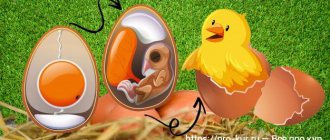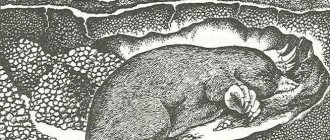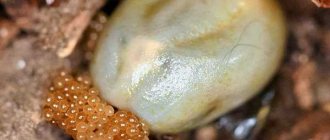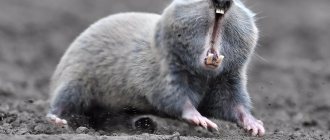Description of moles
A mole is a small soil animal that belongs to the family of mammals . The name "mole" means "digger". They can live in the forest, field, meadow and steppe. The animal lives only in dark places, so its eyes are underdeveloped. But sometimes there are some individuals whose visual organs are able to distinguish darkness from light.
The idea of calling the mole a soil animal came to people when they began to find molehills. This is the name given to piles of soil on the surface of the earth, observing which people discovered a mole. While studying this animal, people determined that it lacked vision. Sense organs such as smell, touch and hearing are quite well developed. The animal's ears are located inside.
Appearance
Moles come in different sizes. Their body length ranges from five to twenty-one centimeters. Weight varies from nine to one hundred and seventy grams. The body is elongated, covered with thick, even fur. Their velvety coat has a peculiarity - a straight-growing pile that is not oriented to any particular side. It has a uniform color of black, black-brown or dark gray, depending on the time of year, species and habitat.
This is interesting! Moles molt three times a year - from spring to autumn. Moles have short limbs. The front paws are wide, shovel-shaped, powerful and with strong claws. The forelimbs are much more developed than the hind limbs. The body ends with a short tail.
The head has a conical shape, there are no ears. The nose is slightly elongated and resembles a trunk. The neck is almost invisible. The eyes are undeveloped; the eyeballs do not have a lens or retina. Very small eye sockets are closed by movable eyelids. There are types of moles whose eyes are covered with skin. Nature has endowed moles with excellent hearing, touch and smell. Their skull is long and conical. The zygomatic arches are very thin. The number of teeth ranges from thirty-three to forty-four. The humerus is strong and wide. Narrow and long pelvic bones.
Character and lifestyle
Moles are very grumpy animals and do not get along well with each other. They live alone, but can unite in pairs to produce offspring. Little moles are affectionate with each other, but as they mature, the males begin to fight. Adults are not able to get along together. Moles are capable of biting and eating their relatives. Due to their uncooperative nature, young moles actively develop territory for their residence.
When one of them dies, the others immediately notice it and take over the tunnel system mastered by the other animal. Moles help mark their territory by secreting a special secretion that accumulates on their belly fur. The animal must regularly mark its possessions so that other animals understand that this territory is not empty.
The entire life of moles passes underground at different depths. Rotating around the axis of their body, they dig the ground with large shovel-shaped inverted paws. If the soil is moist, soft and loose, then the mole breaks through passages from two to five centimeters from the surface of the earth. If the ground is dry, then he will dig passages at a depth of ten to fifty centimeters. Females make their nests at a depth of one and a half to two meters. They often choose a place under stumps, tree roots and stones. The depression above the nest is the highest and reaches eighty centimeters in height. A nest is a small depression lined with grass.
The mole constantly moves around its area in search of a suitable place to live . In the spring, when the snow begins to melt, the animals move to the surface, and in the summer, when the soil dries out, they go down to live in the lowlands. Moles live their entire lives within their area. In hot weather, animals move short distances from their territory, closer to the river for drinking.
This is interesting ! A mole can run through its underground passages head first, but also with its tail at the same speed. The special hair growth helps him in this.
Moles can sleep several times a day for two to three hours. In winter, instead of hibernating, they move through very deep, non-freezing layers of soil. The life of moles is not always safe. When throwing out excess soil on the surface of the earth, they can be grabbed by birds of prey or foxes. Such cases are rare, but they do happen.
How long do moles live?
The lifespan of a mole depends on many factors. The cause of their death is disease and predators. Ticks infect moles with a dangerous disease called piroplasmosis. The main enemies are martens and weasels.
In favorable conditions, moles can live from three to five years. The average life expectancy is four years.
Molting in moles
Moles change their fur coat three or four times a year. They shed in spring, autumn, and even summer. This is due to the fact that the fur wears off quickly due to constant movement through narrow passages. The mole sheds almost all the time, the only exception being the winter period. In those places that have faded, the skin becomes darker and three times thicker. But the hair in those areas holds on less well and is wiped off much faster.
The first molt of the animals begins in April and lasts until June. Females moult first, then males. New wool in the spring replaces the old, worn-out winter coat. Summer molting occurs in adults in mid-July, and after them the first molting occurs in young individuals. Autumn molting begins immediately after summer, without interruption. After it, moles take on their best appearance. Their autumn fur becomes very thick, tall, velvety, and shiny. It is black with a silver tint.
Return to content
general characteristics
In the natural environment, there are several varieties of moles. The smallest representative of the species is the Sichuan shrew mole, its body length rarely exceeds 6–8 cm, its tail is from 5 to 6.5 cm, and the body weight of a mature individual is only 10–15 g. The largest mole is the Ussuri moger, length the body of a mature individual is from 20 cm, and the weight can reach up to 300 g. All moles, without exception, have characteristic features that help them survive underground.
Moles have a short, bar-shaped body, rounded at the sides.
The neck is not pronounced and seems to be a continuation of the body. If you look at the mole from above, it seems that the head grows straight from the shoulders. The shape of the head is cone-shaped, wider at the back of the head with a well-defined narrowing towards the nose.
The animals' ears are vestigial without an auricle. The location of the ear canals is determined by the presence of a skin ridge. In some varieties, the kalik is almost invisible under a layer of wool. The nose of moles is narrow and protrudes strongly above the lower lip; it is mobile and sensitive. The nostrils are wide, located on the sides, but directed forward.
Usually the mole's nose is not covered with hairs, with the exception of long, sensitive whiskers.
Unlike other varieties, the nose of the star-nosed mole ends not with an ordinary lobe, but with unique star-shaped skin outgrowths. They are soft, sensitive and similar to earthworms, the number of outgrowths is about 22 pieces.
Underground life has left its mark on animals. The moles' eyes have lost their intended purpose and are almost completely hidden under the skin. In some species, such as Caucasian moles, the eyeballs can only be seen on an x-ray. In others, the size of the eyes does not exceed the diameter of a poppy seed. Sometimes the eyes are equipped with a regular eyelid, which protects them from dust and soil. But some varieties have small slits in the skin opposite the eyes.
Elena
Ask a Question
Question to the expert
How do moles navigate underground?
Moles cannot see, but they have a well-developed sense of smell and hearing. They are able to smell or hear prey under a thick layer of earth. Animals also navigate thanks to sensitive vibrissae on the nose and tail.
Moles are quite toothy creatures, depending on the species they have maybe 34 to 44 well-developed, sharp teeth. They help hold nimble prey and chew food.
Subterranean mammals communicate with each other using various sounds. They may squeak, hiss or squeal.
Moles have strong and well-developed forelimbs with five-toed paws.
Each toe has a thick, blunt claw designed for digging. The claw is slightly curved outward, and on the inside there is a small depression that allows you to better grip the ground when digging tunnels.
There are no membranes between the fingers, but the hands are wide, spade-shaped and with the palms turned outward.
Under the ground, moles can move forward with their heads or tails. Moreover, the speed in both cases is the same. The fur on the animal's body is located in such a way that it does not interfere with movement. The wool easily bends in the desired direction.
The hind limbs are long, thin and somewhat reminiscent of rat paws in structure. The hind legs have claws, but they are much smaller than the front ones. The tail of moles is quite long, from 2 to 10 cm, its size depends on the type of animal.
Moles are very good swimmers. During a flood, small animals are able to swim across even a strong stream or a small river.
The entire body of animals is covered with soft, dense fur.
The wool grows perpendicularly and has special constrictions in the core. This allows the hairs to bend in any direction and makes it easier for the animal to move underground. Surprisingly, the fur of moles practically does not get dirty; fine debris and dust do not penetrate deeply, but settle at the very ends of the hairs. Therefore, it is enough for the mole to shake itself to clear the soil from its coat.
The color of the coat depends on the type of animal and its habitat. In the natural environment you can find black, dark brown, gray, dark red moles with different shades of fur.
Molting among underground inhabitants occurs 3–4 times a year.
Moles can shed both in the off-season and in the summer. This feature is due to the fact that animal fur quickly wears off from contact with rough surfaces. That is, in fact, the mole constantly renews its fur coat and only in winter does molting not have a pronounced character. Areas of skin where there is no hair become dense and darken. The remaining hairs are quickly wiped off, and new ones grow in their place.
The first molt of moles begins from April to June. Usually the females molt first, followed by the males. The second molt occurs already in July, in adults the spring coat changes to summer, and in young animals the baby coat comes off and an “adult” coat grows. The third autumn moult begins almost without interval; it is well expressed and occurs very quickly. The thin summer coat changes to a thick winter coat. During this period, animal fur is considered the most beautiful; it shines, shimmers, and becomes velvety to the touch.
Question to the expert
Is it possible to have a mole as a pet?
Moles cannot live in captivity. It is important to consider that the animal spends most of its life underground. Therefore, only professionals can provide an unusual pet with comfortable conditions.
Types of moles
Today there are forty species of moles. Here are some of them:
- Common mole (European) . The length of its body is from twelve to sixteen centimeters. Weight from fifty-five to ninety grams. The tail is short, from two to four centimeters. The eyes are very small, there are narrow slits, the eyelids are motionless. The fur is black, but has a light shade underneath. Color can vary from black-brown and black-gray to black. Juveniles have lighter fur than adults. Once a year, offspring appear. Moles of this species live in the forests and meadows of Europe, in the European part of Russia, in the Urals, the Caucasus and Western Siberia.
- Blind Mole . One of the smallest representatives of the species. Its body is only eight to twelve centimeters long, and its tail is two to three centimeters long. Weight reaches no more than thirty grams. The eyes are hidden under the skin. It feeds on insects and their larvae. Very rarely consumes earthworms. It breeds in early spring, before the snow begins to melt. Blind moles live in the mountainous regions of Turkey, the Caucasus and Northern Iran.
- Long-tailed mole . A small animal up to nine centimeters long. The tail measures four and a half centimeters. Has hard fur. They don't dig deep. They live in the highland coniferous forests of Northern Vietnam, Southern China and Northern Myanmar.
- Caucasian mole . Medium sized animal. Body length is from ten to fourteen centimeters. Weight from forty to ninety-five grams, tail length from two and a half to three centimeters. After molting, the bright black fur turns brown. The eyes are located under the skin. The moves are small, from five to twenty centimeters in depth. It feeds mainly on earthworms and very rarely on insects. Bears offspring once a year. It lives in the central and southern parts of the Ciscaucasia, Transcaucasia and the Greater Caucasus.
- Siberian mole . Externally it is similar to the European one, but larger in size. The body length of males is from thirteen and a half centimeters to nineteen. They weigh from seventy-five to two hundred twenty-five grams. Females have a body length of one hundred twenty-eight to one hundred seventy-one millimeters and weigh from seventy to one hundred and forty-five grams. The tail of the animals is short, from seventeen to thirty-six millimeters in length. The eyes have movable lids. The fur is dark brown and black. You can find albinos, red, spotted and yellow individuals. They feed on earthworms and insect larvae. The Siberian mole differs from other species in that their gestation period is nine months. They mate in the summer, but the embryos freeze until spring. The offspring are born between the end of April and the end of May.
- Japanese shrew mole . The body measures from eight to ten centimeters. The tail has hair and a tassel at the tip, its length is three centimeters. The fur is not velvety, but soft and thick, black-brown or black. In winter it can nest in birds' nests. It reproduces once a year. It lives on those mountain slopes that are not inhabited by forest on the southern islands of Japan.
- Japanese mogera . Body length is from twelve to fifteen centimeters. It has a short tail, which is no more than two and a half centimeters. Weighs from ninety-five to two hundred and ten grams. The coat is black, brown or gray on the back and sides. On the belly it has fur of lighter shades. It feeds on insect larvae, but sometimes dilutes the diet with earthworms. The passages are built on two levels: fifty to seventy centimeters and at a depth of one to one and a half meters. They live in the south of Primorsky Krai, in the southwest of the Japanese archipelago.
- Star-Bearer . Its body is from nineteen to twenty-one centimeters long. The tail is long, reaches eight centimeters in length, scaly, covered with hairs. It gets thicker in winter. The star-nosed fish has no ears, its eyes are small, but not hidden under the skin. The fur is dark brown or black, thick. A distinctive feature of this species is its star-shaped stigma, which consists of twenty-two fleshy skin appendages. They are the ones who help the mole find food. The two tentacles, which are located in the middle at the top, are directed upward and do not bend. All others are movable. This type of mole is an excellent swimmer and can dive even under ice. In water it feeds on fish, on land - mollusks and earthworms. The starfish can move both on the ground and in the snow. They live in forests and meadows, near swamps and along the banks of streams, they love moist soil. They live in the southeastern states of the United States and parts of Canada.
Return to content
What is the name of a baby pigeon?
No matter how trivial and simple it may sound, pigeon chicks are called just that - pigeon chick. In colloquial speech they use “little dove” in the singular and “little doves” in the plural.
Interesting materials:
How to choose a DNS server? How to choose walnuts on the market? How to choose an icon for your home? How to choose a good halibut? How to choose Okved for individual entrepreneurs 2022? How to choose an optical cable for audio? How to choose satin bed linen? How to choose an amplifier for wi fi? How to choose honeysuckle? How to issue a power of attorney?
Range, habitats
Moles live almost throughout Europe and Russia. The exception is the Arctic Circle region. You can meet these animals in Turkey, China, Tibet, Indochina, Transcaucasia and Mongolia. Moles inhabit southeastern Canada, the west coast of the United States, and Mexico. There are a huge number of moles living in the European part of Russia. In the Asian part of Russia, moles live in Western and Central Siberia, Altai, the Far East and the Sayan Mountains. It is important for animals that the soil is suitable for digging. They prefer loose and soft soil, but do not like swampy areas.
Forest glades, meadows, forest edges, deciduous forests and agricultural areas are the favorite territory of moles. Moles' habitats are plains, hilly areas and mountains. Moles do not live in extremely dry and hot areas, such as deserts and semi-deserts. They will not be able to get along in frozen tundras and forest-tundras. To the north, to the middle taiga and to the southern steppes, animals spread along river valleys. In those areas that are their habitat, moles create burrows and passages of complex structure. Some of them become home for them, but they need the main passages to get food.
Return to content
Diet of moles
Earthworms form the basis of nutrition for most moles. They also feed on insects that live in the ground and their larvae. These include wireworms and weevils. May beetle larvae and flies are also included in the diet. Some moles feed on slugs. Mogers eat caterpillars and butterflies.
This is interesting! Thrifty animals collect up to a thousand earthworms in their tunnels during the period of lack of food. Moles emit a musky odor that attracts worms. Therefore, they themselves crawl into the tunnel, which was previously dug by the mole. In winter, the animals hunt for worms, digging holes in the floor with snow.
The animals feed five to six times a day . After each meal, the moles fall asleep for four hours so that the food is digested during this time. At one time, a mole eats from twenty to twenty-two grams of earthworms, and in a day from fifty to sixty grams. Starting from the end, the animal eats the worm whole or torn. The teeth and toes on the front paws help squeeze the soil out of the worms. In winter, moles eat less than in summer. You can fast for no more than seventeen hours.
Return to content
What do they eat?
The diet of most varieties consists of earthworms, slugs, snails, insects and larvae that hide underground or in dead leaves. But starfish, in addition to their usual food, can feed on small fish, shellfish and other underwater creatures. And mogers supplement their menu with butterflies and caterpillars. In addition, many varieties include plant foods in their diet.
On average, moles feed 5 to 6 times a day.
After each meal, the animals curl up into a ball and fall asleep. Sleep lasts from 3 to 4 hours, the mole spends this time digesting food. In one meal, the animal eats about 20–30 g of worms and insects; per day, the amount of animals eaten can exceed 90–100 g. In the summer, the amount of food eaten increases, as the heat speeds up metabolism.
Moles have a high metabolism, so they must eat a new portion every 14–17 hours. If the animal does not find food, it may die of hunger.
After the mole catches the worm, it eats it whole or tears it into small pieces. But before eating, the animal always squeezes the earth out of the worm’s body.
Reproduction and offspring
Climate and habitat quality affect the duration of the mole breeding season. The rut begins at the end of March. Adult females begin breeding earlier than young ones. To mate, moles come to the surface of the earth.
The animals' pregnancy lasts from thirty to sixty days. The exception is the Siberian mole, whose offspring appear only after nine months. Newborns begin to be born from the end of April. At birth they are naked and blind. They are born in numbers from three to ten pieces. Moles usually have only one litter per year. But the greater Moguera breeds twice a year. Mole babies grow quickly and within a month they are already the same size as adults. Puberty in females begins within a year, in some species within a few months.
Return to content
Lifestyle and character traits
The mole's entire life is spent underground. Animals very rarely leave their tunnels and come to the surface.
A massive emergence of moles can only be observed during the breeding season or spring flood.
Lifestyle
Moles dig long but shallow passages, rotating around their axis and spreading their paws. If the move is shallow, then a small roller appears above the surface, and all the earth is compacted. But when constructing permanent tunnels at a depth of 15 cm, the mole throws excess soil to the surface.
A pile of earth around the entrance to the labyrinth can reach a height of 50 to 80 cm and is called a molehill.
Elena
Ask a Question
Question to the expert
Do moles hibernate?
Moles do not hibernate, but in winter they practically do not appear on the surface. They stock up and eat from their pantries all winter. But animals can make tunnels under snow and fallen leaves in search of additional food.
Character and habits
Moles are famous for their thriftiness. Animals build pantries in their tunnels and store food in them in winter and summer. Most animals have several storage rooms, in case they have to leave their main home.
Moles do not dig a hole every time they go in search of food. Usually the worms themselves crawl into dug tunnels based on the musky smell and heat that the underground animal gives off.
Underground inhabitants lead a solitary lifestyle and unite in pairs only during the mating season. Moles are very quarrelsome and jealously guard their territories from outsiders. They mark the boundaries of their possessions with an odorous secretion that accumulates on the fur in the abdomen area.
Natural enemies
Moles don't have many enemies. A specific smell saves them from predators. Sometimes they can still be caught by birds of prey. This happens during spring floods. The animals' enemies are martens, wild boars, badgers, foxes, and raccoon dogs.
The only predator that is the main enemy of the mole is the weasel. She happily sneaks into their passages and catches them. The weasel does not even disdain the musky smell of a mole, which other animals do not like so much.
During the rutting period, the weasel makes a sound that moles always recognize and, sensing danger, run away. Droughts and waterlogging can kill moles. People are also the cause of the death of these animals, as they are capable of killing them either accidentally or intentionally.
Return to content
What is the name of a female crocodile?
You can always contact us
| Parents | Cub (child) singular | |
| Crocodile | Crocodile | Crocodile |
| Raccoon | The correct word would be a female raccoon, but you can also find the names raccoon or raccoon. | Puppy |
| Eagle | Eagle | Eaglet |
| Male monkey | Monkey | A baby monkey, and colloquially a baby monkey can be called a “monkey.” |
Population and species status
Most moles are inveterate loners . Each animal has its own area. Males and females defend their entire territory very zealously. They unite only for a short period of time to continue the family line. After mating, the male no longer participates in the life of the female and his children.
This is interesting! Population densities vary by habitat and species. Males begin to greatly increase the size of their territories in the spring. In the mole population, there are from five to thirty individuals per hectare of land.
The common mole is of great importance in the economy. Previously, this animal was considered as an object of fur trade. After gaining popularity, the species began to need protection. Today, there is no hunting for moles in Russia, which has led to an increase in their numbers. The growth of the common mole population is favorably influenced by warm winters and good conditions for its reproduction and feeding.
Return to content
Moles and man
Moles exterminate plant pests, thereby benefiting agriculture and forestry. The animals loosen the soil and, thanks to this, soil drainage occurs. This action benefits gardens and vegetable gardens. The benefit can turn into harm if the animals begin to breed in this area. They can dig up paths, flower beds, and plant roots. Earthworms, which moles feed on, are very useful for soil formation. Eating worms is also a pest from moles.
If an animal settles in a dacha or personal plot, then it will harm the crops and harvest by digging. The trees that grow in the garden will also deteriorate because their roots will be exposed by the actions of the animal.
In the modern world, special preparations have been invented that can scare moles away from your area with sound and ultrasound. In addition to devices, folk methods are also known that help fight these animals. You need to put a rag in the molehill, which will be soaked in ammonia or mothballs. A strong-smelling product will drive the mole away from the place with its smell. In such cases, the animals’ sensitive sense of smell plays against them.
Moles do not like loud sounds and vibration . If you stick metal rods into the ground, on which cans hang and knock against the rod from the wind, then the animal will not be able to live in such an area. Another folk remedy is repelling moles with the unpleasant odors of certain plants. These include beans, peas, daffodil, imperial hazel grouse, lavender, calendula, onions, and garlic.
This is interesting! Pieces of glass, metal or bones can be placed in the ground to repel animals. In order not to get hurt yourself, you will need to be especially careful.
Don’t forget, after you drive the animal away from your property, to build any mechanical obstacle that will prevent it from returning after some time. For example, you can dig a fine metal mesh, slate or concrete to a depth of at least eighty centimeters around the entire perimeter. This method is not cheap, it requires a lot of effort, but it is one of the most effective.
Return to content
How to get rid of moles on your property - practical tips!
The Internet offers many ways to destroy moles on your property. Most of them do not stand up to criticism even on a theoretical level! One piece of nonsense, written by an amateur who has never seen a mole in his life, can wander from site to site, rewritten and altered by diligent rewriters. But in fact, most methods turn against the gardeners themselves, who, out of ignorance and naivety, try to use them.
What does not work and what should not be done:
- Traps and traps that are proposed to be installed “directly in the hole.” Dear gardeners, go ahead and find this hole! Those piles of earth that you see on the surface are not the entrance to the hole! The mole thus gets rid of construction waste, throwing it away from housing. And you yourself probably don’t pile up construction waste in front of the main entrance. The mole too, but in this case he is concerned not so much with aesthetics as with his own safety. Having pushed out the excess earth, he fills up the hole from the inside and moves away from this landfill. To find a hole on your own, or at least one upper-level tunnel, you need to dig up your entire garden like a mole. Only an experienced professional who has been involved in pest control for years and who has developed a professional sense of smell, based not just on intuition, but on fundamental knowledge, can quickly find the lair of an underground inhabitant.
- Use of kerosene, other flammable mixtures and pesticides. All you will achieve is to poison the soil, on which nothing will grow for several years, and maybe even decades.
- All kinds of rattles and noisemakers. This method will make you run away from the site faster than a mole.
- Ultrasonic repeller. It works 50/50. One mole may be disturbed by ultrasonic waves, while the other will simply ignore them. Moles, of course, pick up both infrasound and ultrasound. They perfectly perceive vibrations in the ground, the movements of other animals, and even human steps on the surface of the earth. Another question is whether the mole perceives these signals as a threat to life? In any case, the fact that he hears the movement of a person above his ceiling does not prompt him to run headlong from his carefully thought out and masterfully executed home.
What works:
- The most ordinary village semi-wild cat, who lives on the street, and not on a soft sofa and is not spoiled with delicacies, will rid your property not only of the mole, but also of all running, jumping and crawling creatures - rats, mice, frogs, lizards and even snakes . This dexterous hunter will be able to determine better than a professional pest control agent where to dig the ground with his paws in order to catch the mole. Any fundamental knowledge pales against the background of animal instincts.
- Repellents of both natural and chemical origin have a good effect. Companies that professionally deal with pest control always have a large selection of them. These preparations imitate odors that moles cannot stand, but they are completely safe for people, plants and pets.
Be picky about your means, no matter how they justify the end! Take care of yourself and your loved ones.
Video about moles
Return to content
Tags: talpidae, habitat, appearance, wild animals, long-tailed mole, star-nosed mole, Caucasian mole, mole, common mole, moles, nutrition, population, natural enemies, reproduction, diet, Siberian mole, blind mole, Japanese moguera, Japanese shrew mole











